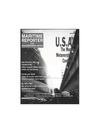
Page 55: of Maritime Reporter Magazine (August 1999)
Read this page in Pdf, Flash or Html5 edition of August 1999 Maritime Reporter Magazine
Clipper Harald is the culmination of a coopera- tion between German companies Meyer Werft
Shipyard and Thyssen Nordseewerke, which have collaborated to produce two exceptional quality gas tankers that are competitive with dominant niche players in the Far East. for such work. Two German companies — Krupp Fordertechnik GmbH and
Thyssen Nordseewerke — recently completed the first construction phase of the largest trailing hopper dredge,
Vasco da Gama. With the first bottom section, the keel of the jumbo dredger was laid on the slipway of Thyssen
Nordseewerke yard at Emden the end of last April. The company, along with its partner Krupp Fordertechnik GmbH, has been working on the newbuilding for the past year. Scheduled for delivery at the beginning of 2000 to Jan de Nul group of Belgium, the dredger measures 656 ft. (200 m), with a 118.7 ft. (36.2 m) breadth and 33,000 cu. m hopper capacity. With 36,000 kW installed power for speeds of 16.5 knots, it will be used mainly in land reclamation.
Maintaining The Edge
It is no secret that the German mar- itime industry has earned the respect of the international maritime community for its high quality of product and ser- vice. Earning and maintaining such a reputation, however, comes only through dogged pursuit of devising increasingly innovative and effective solutions to the many challenges pre- sented by the rugged maritime environ- ment. Advanced work in the areas of
Research and Development is perhaps best embodied by the continued efforts of classification society Germanischer
Flender Werft recently delivered the fifth of its
Flender 2100 type containership to Hamburg owner Claus-Peter Offen.
Lloyd (GL). GL, led by Dr. Hans
Payer, continues to make impressive strides in many different areas of the maritime realm, with the goal of each project firmly entrenched in the "real business" side of enhancing maritime efficiency and safety. Most recently, GL launched project WaveLoads, which will be an advanced method for predict- ing wave induced loads for high speed ships. In announcing the project, GL said that to ensure their competitive positioning world markets, European shipyards need to be able to produce modern high speed ships that conform to the highest safety standards, while operating in the increasingly congested waters, which have become the hall- mark of European short sea shipping routes. GL commented that classifica- tion society rules provide formulas for safe design loads, but they tend to reflect the service experience of existing ships and will not adequately account for future larger scale ship designs. The three-year Waveloads project is sched- uled to culminate in the establishment of guidelines and recommendations for hull structural improvements and hull developments for high speed ships.
Technological evolution is one of the the very first commercial hydrofoil of passengers and up to 450 cars and was already on the seas when our to reach the highest level of perfi and comfort standards even in vei
A record coming from the expert / ^^^^^ assets of Rodriquez Cantieri Navali fast ferries. In 1956 we launched lipping history. Today we are building%rries able to carry up to 1,500 of +50 knots. We might not be the or% ones, but the Aquastrada ipetitors were just working on fast vessels, the Aquastrada continues ance in its class using the lowest number of kW, holding high safety 3vere seas. of Rodriquez Cantieri Navali, high speed inventors for civil navigation.
RODRIQUEZ CANTIERI NAVALI SPA
Via S. Raineri, 22 98122 Messina, Italy
Phone+39.090.7765283
Fax +39.090.7765293
E-mail: [email protected] www.rodriquez.it eff&emm • mcssina ® RODRIQUEZ CANTIERI NAVALI SPA
Circle 277 on Reader Service Card
August, 1999 55

 54
54

 56
56
